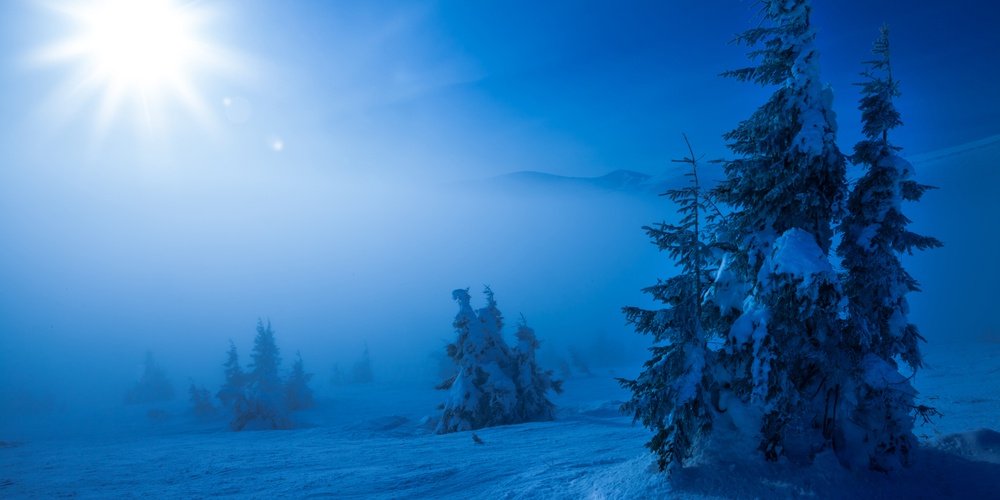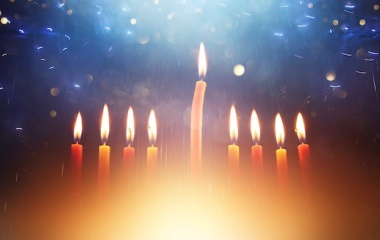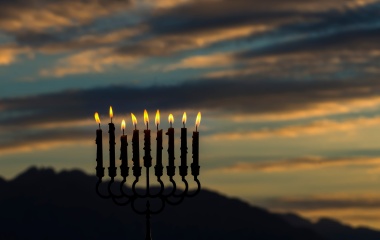
Of all our holidays, only that of Chanukah begins in the second half of the month. Rosh Hashanah, Yom Kippur and Shavuot occur towards the beginning of the month, when the moon is growing stronger. Pesach, Sukkot, Purim (at least in Jerusalem), Tu b'Av, and Tu b'Shvat are all celebrated on the 15th of the month, when the moon is full. Even Tisha b'Av falls during the first half of the month. Our Sages saw within destruction the seeds of redemption and the birth of the Mashiach.
As the redemption from Egypt was set to begin, the first mitzvah given to the Jewish people was to sanctify the moon. The sun, constant and consistent, represents the unchanging and unforgiving natural world. Waxing and waning, the moon symbolizes the ups and downs of life, with periods of strength and periods of weakness. Similarly, the Jewish people--whose miraculous existence defies the natural rise and fall of nations--are wont to see our fortunes rise and fall. Unlike Shabbat which marks G-d's creation of nature, the holidays are forged by the partnership of man and G-d, by the Jewish people taking the initiative at crucial junctures in their history. It is man who must sanctify the moon.
Not only does Chanukah defy this pattern, beginning when the moon is least visible, it is the only holiday that occurs during the long winter nights. It is readily understandable why Chanukah is celebrated by the ever increasing numbers of lights, as we aim to dispel both lunar and solar darkness.
The holidays are a twinning of historical events with the agricultural cycle of nature: Pesach in the spring, Sukkot in the fall and Shavuot in the summer. Tu b'Shvat marks the end of the rainy season and Tu b'Av marks the end of the summer heat (see Ta'anit 31a). The G-d of nature and the G-d of history is one.
While it would appear that Chanukah is an exception to this dual character of the holidays, lacking (as it does) an agricultural motif, a fascinating Talmudic piece would seem to suggest otherwise. In explaining the origins of the pagan festival kalenda (perhaps linguistically related to calendar), the Talmud (Avodah Zara 8a) claims that after Adam sinned in the Garden of Eden, he began to notice that the days were getting shorter. He feared that it was his sin that was causing this increasingly early onset of darkness, and would lead to the world's eventual return to nothingness. As the winter solstice brought longer days - ancient man had a much keener sense of nature than we do - he breathed a huge sigh of relief and declared, olam kminhago noheg, this is the way of the world. He then marked the occasion with an eight-day celebration. The Talmud notes that leshana acheret, in a future year, "they" made this into an idolatrous festival and "we" made it into a Jewish one.
While it would take many generations, it appears that here we have the origins of what would later become Chanukah (and, lehavdil, Christmas). Interestingly, the language used in the Talmud, leshana acheret, in a future year, is the same language used to describe the establishment of Chanukah (Shabbat 21b), whose celebration apparently did not begin until years after the actual events.
Furthermore, it appears that the 25th day of Kislev was specifically chosen to be the day of Chanukah, of rededicating the Temple. The day had historical significance. The prophet Chagai (2:10-19) records that the cornerstone of the second Temple was completed on the 24th of Kislev and celebrations began on the 25th.
Megilat Taanit, which serves as the basis for the Chanukah story, notes that the Maccabees first entered the Temple on the 23rd day of Cheshvan. They then had to repair and rebuild many of the Temple vessels, something that would take some time. It was apparently during Cheshvan that the miracle of the oil took place, with the 25th of Kislev chosen as the day to re-inaugurate the Temple service. It simply would have not been possible to enter the Temple, light the menorah and dedicate the Temple all in a period of just eight days. (For a detailed explanation of this fascinating and compelling theory see Rabbi Daniel Sperber, Mihagei Yisrael, volume 5). We combine the miraculous lighting of the menorah with the daily lighting, bringing them together in one festival; the natural and the supernatural are just differing manifestations of the miraculous.
Chanukah emphasizes that even during the darkest times there is growth and renewal beneath the surface. Our enemies may outnumber us and our natural resources may be few, but the Jewish people always defy the odds. Many Jews still alive were witnesses to the darkest moment in all of Jewish history. Let us pray that that the light of Chanukah dispel the areas of human darkness leading the world to the peace it so desperately needs.



